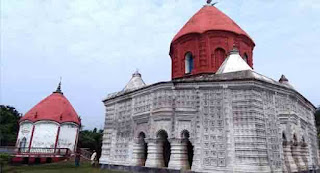Naldanga Rajbarir Pancharatna Mandir, Jhenaidah BD
Naldanga of Jhenaidah has 7 temples standing as a witness of the history of ancient traditions. The arrival of domestic and foreign tourists is happening. The location of this ancient place is in Rajbari, about 15 kilometres south of Sadar upazila and 5 kilometres north of Kaliganj upazila city.
Even though the temples of Rajbari is destroyed in the times of Pakistan, the temple of Kalimata, Lakshmi temple, Ganesh temple, Durga temple, Taramoni temple, Bisnu Temple, Rajeshwari temple, and 7 beautiful temples are standing on the banks of the Begabati river.
Naydanga village of Sadar upazila of Jhenaidah now stands as a witness of seven beautiful temples of Raja Bahadur Bhushan Debroy. Indeed, this Naldanga Raj palace and the history of the dynasty have been lost in the times of Pakistan. Now, these monuments are in the memory of the king as well.
It is known from the local people and history, about five hundred years ago, the original male descendants of this dynasty lived in the village of Vabrasur, in the suburb of Telihati Pargana of Faridpur.
One of his descendants Vishnu Das Hajra established the royal family in Naldanga. He got the title of Hajra by getting the job of Nawab. His father`s name was Madhav Yuvraj Khan. He used to serve as Nawab. In his old age, Vishnu Das became a monk with a special fondness towards religion. He came to Khardasing village near Naldanga from Faridpur, Bhabrasur. He started austerities in a jungle on the banks of the river Begabati.
It is said that in 1590, after the conquest of Bengal by Mughal Subedar Mansingh, was going to the capital with the river Begabati by boat. His soldiers saw Bishnu Das Sartri and went looking for help collecting supplies. At this time Bishnu Das collected very fast supplies of the soldiers.
In this, Subedar Mansingh became happy and donate some supplies to the five other villages. Initially, these villages became Zamidari, and gradually it was established as Naldanga State. The area was full of pipe nets, so the place was called Naldanga.
After about three hundred years, various rulers of this dynasty ruled this state at different times. Various rulers have established these temples at different times.
Then, in 1870, King Indu Bhushan died of tuberculosis, his son, adopted son Raja Bahadur, took charge of the first Bholan Devala state. He established this few extinct temples of today, which is standing on the banks of the river Begabati as a witness of time.
After nine years of King Indu Bhushan`s death, in 1879 Raja Bahadur took the charge of full Zamidari. In 1913, he was awarded the title of King Bahadur. At that time, he started Madhumati scholarship in the name of parents and mother. He established the government`s Naldanga Bhushan High School in 1882 near Rajbari, which is now situated at the heart of Kaliganj.
Raja Bahadur died on 18 February 1941. He had two sons named Kashi Kumar Parnag Bhushan Devra and Kumara Murugank Bhushan Devra. According to a government order in 1955, the Zamidari status went under the control of the government. The royal lineage disappeared for the last time. It is known locally as Naldanga Moth or Naldanga Rajbari.
Locals demanded that 7 reforms of the temple would increase further if there were foreign and domestic tourists. Therefore, It is expected by local people that as soon as the Department of Democracy and the district administration will improve the temples.






Comments
Post a Comment